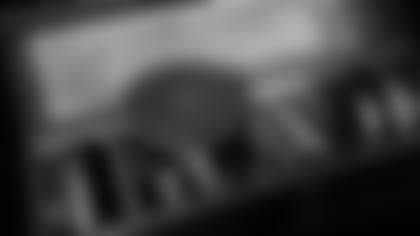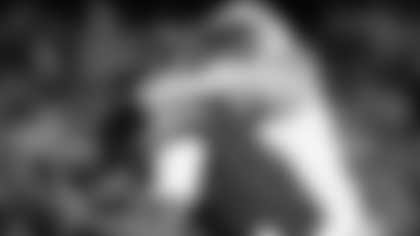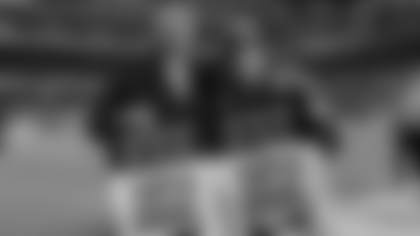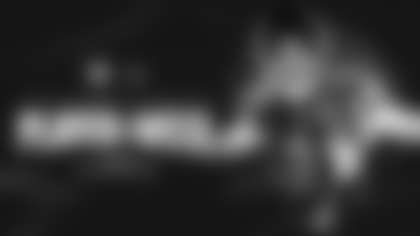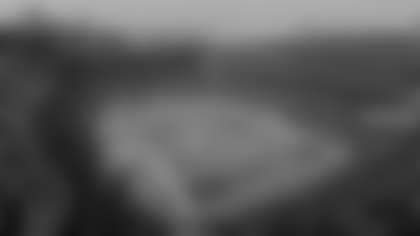Bears fans uncover long-lost footage of historic game
A suburban family discovered footage of Red Grange's first game with the Bears, taken on Thanksgiving Day in 1925 at Wrigley Field.
By: Nathan Smith | Dec 11, 2019
You never know what you're going to find in family storage.
After their father, Robert, passed away in 1997, Patrick, Paul, and Mike McKearnan began the process of sorting the things their father had left behind. Among them, there was a beat-up, wooden box with flaking gray paint and rusted hinges.
Inside the box, the McKearnan brothers found a trove of small film reels. Once they found the proper device to play the film, a 16mm projector, they sat down together to watch the footage their father had left them.
At first, it was just a film of a family vacation. They saw Robert as a toddler, their grandfather, Thomas, no doubt, behind the camera. Everything was black-and-white and silent, shot well before the advent of "talkies" in 1929.
Between vacations, with their father still no more than a few years old, the setting changed. A big crowd swayed in a stadium. Men in leather helmets collided with each other and jogged off to the sideline. Cut to four men sitting on the sideline, bundled up in the cold, while a little boy dashes in and out of the frame.
"I think we knew we had something special, but we didn't know what at the time," said Mike McKearnan. "We weren't positive of the time frame, what game it was, who was playing. You couldn't really tell from the uniforms 'cause it's pretty hard to see, but we knew we had something old and something special."
For three-and-a-half minutes, the camera swerved around a raucous football game, then switched back to a family vacation.
Two decades later, when the brothers decided to convert the decaying film into something more accessible and durable, the thought occurred to them about that particular little film segment. By then, they thought they recognized one of the faces on the screen. If they were right, they knew who might be interested in that old film reel.
"We thought, you know what?" said Paul McKearnan. "This footage really belongs with the Bears."
As lifelong Bears fans growing up in the northern Chicago suburbs, the McKearnan brothers relished the chance to do a good deed for their favorite team. Once the Bears organization got a good look at the footage, they let the McKearnan brothers in on a secret: the film they had discovered was not of any old game.
"The first time I saw it," said Bears vice president Brian McCaskey, "I couldn't believe what I was seeing. I felt like, 'Wow, this is the Holy Grail of historical footage in terms of what it means to the Bears.'"
To understand the gravity of what the McKearnans gave the Bears, one needs to consider the state of the NFL in the early 1920s.
George Halas and his star player traveled to the White House to meet President Calvin Coolidge. Upon the introduction of members of the Chicago Bears, the famously terse president offered what he perceived to be a compliment.
"Glad to meet you," said Coolidge. "I always did like animal acts."
Such was George Halas' life as a young man: the president who had just carried almost the entire industrial midwest in the 1924 election met the father of the NFL and assumed that Halas was the ringmaster of a traveling circus.
That would change soon enough, thanks primarily to the player who accompanied Halas to Washington.
College football had become a mainstream attraction by the outbreak of World War I a decade earlier. Knute Rockne had turned Notre Dame into a football shrine for Rust Belt Catholics. The service academies Army and Navy perfected the art of rivalry. The University of Chicago built a powerhouse, originating the term "Monsters of the Midway."
George Halas' Decatur-then-Chicago Staleys-then-Bears were barely drawing 5,000 fans a game in the country's second-largest market.
The pipeline from college stardom to an NFL team was not yet under construction in the league's early years. In 1935, the Bears failed to reach terms with Jay Berwanger, the first Heisman winner, when Berwanger found more lucrative employment for a local rubber company.
There was no Heisman Trophy in 1925, but there has never been any doubt who would have won the award: a running back at the University of Illinois named Harold "Red" Grange.
Grange was a national phenomenon. After multi-sport athlete Jim Thorpe, he was football's second superstar. With his graduation imminent in Champaign, Grange was weighing a trio of lucrative options.
First, he could capitalize on his football prowess by moving to Hollywood and becoming a movie star. This offer would follow him for years, and he would eventually go that route.
Second, he could have heeded the petition circulated by Chicago Republicans, urging him to run for Congress in 1926, despite being under the constitutionally required age of 25.
Third, and perhaps most unusual, he could take a two-hour train ride up to Chicago and join Halas, himself an Illinois alum, with the Chicago Bears.
Grange surprised many when his handler, C.C. Pyle, reached terms with Halas to join forces and go on a barnstorming tour around the United States, including a stop in the nation's capital to meet the president.
But first, the new marriage would kick off in Chicago.
Days after his last game for the Illini, Grange was at a sold-out Wrigley Field--or Cubs Field as it was then called--on Thanksgiving Day. If the league was born in 1920 in Canton, Ohio, it was christened five years later in Chicago. The biggest star in the country was going to try his hand at professional football.
The game was far from a barnburner, finishing in a 0-0 tie, but the memory lived on in the thousands of adoring fans and one photo of Halas, guard Bill Fleckenstein, Grange and Pyle sitting on the sideline with a blanket pulled over their knees.
There was no known footage taken of the pivotal game, or so the world thought until three brothers in the northern suburbs decided to clean out their late father's storage shed.
Dan Yuska has worked in operations and historical affairs for the Bears since 2002. Among a wide variety of responsibilities, he helps to manage the archives of the team, which are more expansive and reach back farther than likely any other professional football team. At the time the McKearnans reached out, the team's inventory of game footage dated back to 1936.
Yuska knew when he saw an enhanced version of the McKearnans' video that he was looking at something unique.
The first clue was the crowd size. Wrigley Field, recognizable even 94 years in the past, was packed to watch the Bears. This wasn't a regular occurrence.
"Looking at the footage, you could tell that Wrigley Field was at capacity," said Yuska. "There were fans on the roof. There were fans on the sideline."
In the pre-Grange 1925 season, the Bears had an average home attendance of 6,500, a slight improvement from the team's inaugural Chicago season in 1921. On the Thanksgiving Day game, 39,000 people attended. The Bears wouldn't reach that mark again until 1937.
In the aftermath of the addition of Grange, the team occasionally saw crowds as large as 20,000, and Grange's final two games in 1934 saw an attendance just above 30,000. So how could Yuska know that the crowd on the film was the first Red Grange game and not the last? He turned his attention to the field and the players lining up against Grange.
The opponents' jerseys are unmistakably that of the crosstown rival Chicago Cardinals, who were the opponents on Thanksgiving Day of 1925.
These two points merge into one anomaly. Despite playing in the same city, Bears-Cardinals games were never a great draw. Tens of thousands of fans would flock to Wrigley Field when the Green Bay Packers and later the Detroit Lions came to town. But when the Cardinals journeyed north of their home at Comiskey Park, both teams' fans stayed home.
The next time that attendance for the matchup would come close to selling out Wrigley Field was in 1949 when leather helmets had been abolished, and Sid Luckman was wrapping up his career.
As if to prove the film's legitimacy, the cameraman pans over the sideline, catching Halas, Fleckenstein, Grange, Pyle and a little boy in a fur coat in the exact arrangement as the only known photograph in the game.
"Everything is the same," said Yuska. "From what the players are wearing, from the order they're sitting on the bench, to these kids. Everybody in this frame is in the exact same position as in that game footage."
Yuska didn't feel qualified to opine about the film's broader meaning, other than to express gratitude to the McKearnan family for bringing it to the organization's attention.
"From our end of things," said Yuska, "dealing with a lot of the Bears memorabilia and history, now you have this piece of a remarkable, significant game that you have preserved. You have that now going forward, and you didn't know it existed before the McKearnan family came forward. That's why I give so much credit to them for sharing that with us."
None of the McKearnan brothers can be sure how the video came to be. Neither their grandfather or father ever made mention of being present at Red Grange's first game.
"We're pretty sure he's the one that took the movies," said Michael McKearnan. "We have no idea how he got onto the sidelines because he had to be right on the sidelines to get this footage, so I don't know what special relationship he had, but he must've known someone to get down there to get footage right from the sidelines."
To this end, two tidbits of McKearnan family lore seem relevant.
First, Thomas McKearnan was in the photography business. The Moffett Studio, where he worked as a salesman and later executive, was a pioneer in the relatively new field. The studio was noted for its portraits of well-known figures, including presidents, popes, and the picture of former Bears executive Ralph Brizzolara that hangs to this day in Halas Hall.
The Moffett Studio did not, to the McKearnans' knowledge, traffic in moving pictures. Still, Thomas McKearnan lived in a world that may have given him access to a primitive film camera, which was very rare at the time.
Second, all three men remember their father had an amusing habit of getting onto professional sidelines with little more than confidence and daring.
"I'd go a game with him," said Paul McKearnan. "I'd think he's going to the bathroom. Next thing I know, I look down, and there's my dad on the field."
If Robert learned that habit from his father, it's possible that Thomas McKearnan took the video himself. Even for a big day like Red Grange's first game, it's hard to imagine the fledgling NFL was practicing the rigid field security measures we know today.
While the McKearnans waxed nostalgic about their father and grandfather, there was another family at Halas Hall to whom the footage held deep meaning.
While other footage exists of Red Grange's playing days, all previously known footage of George Halas had been in his capacity as a coach. Halas retired as a player in 1928 at the age of 33, and few living people had ever seen the father of the NFL in action at right end.
Brian McCaskey had never watched his grandfather as a player. Halas didn't talk much about his on-field experience to his grandchildren, preferring to regale them about all the exciting and remarkable people who crossed his path.
"It was a very strange feeling, very surreal feeling," said McCaskey. "Up until that moment, it had always just been photographs. It had never been film."


